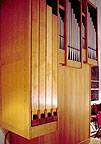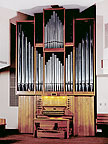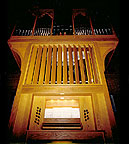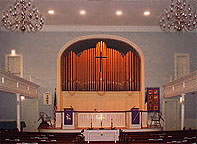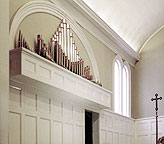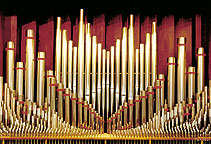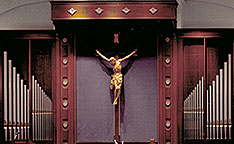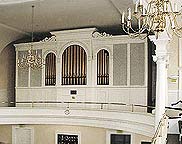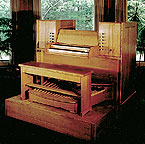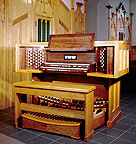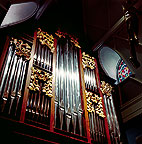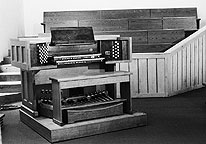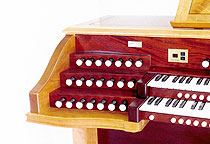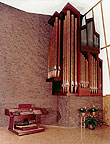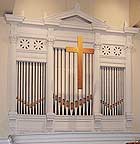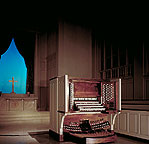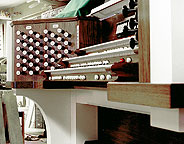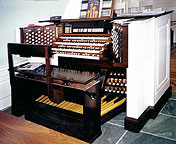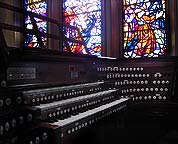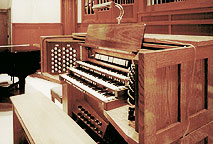It
might be called the Jessye Norman of pipe organs, custom-designed and
fitted and possessed of a powerful pair of lungs. But Its builder,
Stephen J. Russell simply called the organ his Opus 27 as he supervised
its recent Installation at the South Salem Presbyterian Church here.
Organ
experts talk in human terms about their Instrument. Organs have voices,
their pipes have lips, ears, feet and toes, they inhabit rooms of
their own. Or, as the organist Robert Fertitta pointed out one recent
morning here, the organ room Is the Instrument, because the chamber
Is filled with the pipes and wind mechanisms that produce sound.
Mr.
Fertitta, music director of the church, was nearly bursting with
excitement as he worked alongside Mr. Russell and his crew. The organ
builder, president of Russell & Company of Cambridgeport, Vt.,
had spent more than four months making the instrument for the church.
It was rare, Mr. Fertitta said, for a hamlet like South Salem to
acquire the grand dame of musical Instruments, let alone one specially
made by a fine craftsman. He predicted that the new pipe organ would
attract musicians from far and wide.
The
225-member congregation began Its organ drive two years ago, ra/ising
more than $120,000 to replace its electroniC organ with a new instrument
and renovate the 20-year-old white clapboard church. A balcony of
pews was ripped out and a new enclosure built; the floor of the organ
room was strengthened to prevent vibration, and electrical work was
done.
Cut
into the new wall high above the chancel, where a workman was now
installing some of the organ's 1,192 pipes, were rectangular openings
that marked the instrument's facade. Unseen behind this simple face,
an elaborate mechanism would produce music, as organs had done for
1,000 years. Bach was said to test what he called "the lungs" of
every new organ he played. Now, as the week-long installation here
neared its end, Mr. Russell began the painstaking job of tuning the
new instrument and testing its lungs. "Each pipe is indIvidually
adjusted for volume, tone quality and articulation," he said "Each
pipe has its own unique shape, which determines tone." He was
seated at a console in the sanctuary, shouting instructions to workers
up in the organ chamber.
"That's
slow and a hair soft." he said as he played one pitch. "A
little more drive, please, a little more wind" Another pitch
had a different problem. "That has a bright sizzle in it," he
said, "and it's a hair loud" if the adjustments sounded
like the efforts of a bad flute or recorder player, it was because
organ pipes are constructed like recorders, Mr. Russell said. But
the longest pipe of the South Salem organ is eight feet long, while
the working length of the shortest pipe is one quarter inch and approaches
the sound of a dog whistle. As in most contemporary organs, this
one receives wind by means of an electrically driven blower; holes
In the "toe" or bottom of each pipe allow the air in. If
a particular pitch is not desired, the air hole is covered or stopped;
hence the expression "pull out the stops" in organ parlance.
The
county's newest organ, with 20 ranks - or sets - of pipes, is of
medium size compared with some others in the county. Mr. Fertitta
said the organ in the Rye Presbyterian Church, with 68 ranks, is
the county's largest. Mr. Fertitta often plays the world's largest
movable organ, the 59-rank Flentrop pipe organ owned by Purchase
College. He dresses up like Bach to play the Flentrop for schoolchildren
and has performed the Saint-Saens Organ Symphony on it with the Westchester
Philharmonic.
Mr.
Fertitta, an associate professor of music at Purchase College and
director of the Sacred Music Program there, has also performed with
the Philharmonia Virtuosi and the Westchester Symphony. He is a seasoned
recitalist and accompanist who has played at St. Patrick's Cathedral
and Columbia University. He deserves a fine Instrument, said George
VanMarter, a member of the congregation and choir at the South Salem
Presbyterian Church.
Mr.
VanMarter said it was "a financial stretch" for the congregation
to buy the organ but that a good instrument was necessary "to
bring in people of the quality of Robert Fertltta." He said
he hopes the new organ "would be enjoyed for many generations
to come."
Mr.
Fertitta, meanwhile, was gleefully ready to dismantle the old electronic
organ that he had played since coming to the church a year ago.
"It's
shot, just about dead" he said, pulling the plug on the pipeless
console. While the old Instrument produced a sound with "transistors,
electrodes and speakers:' he said, the pipe organ "creates sound
with air, and you can feel it" He added: "It has a wonderful
way of combining with the human voice because that, too, is wind.
An electronic organ is just like turning on a stereo."
Mr.
Fertitta and the organists Anthony and Mary Jane Newman will present
a free concert to dedicate the new organ In the 350-seat church next
Sunday at 4 P.M. Ms. Newman is a former music director
of the, church, and her husband helped design the organ. The concert
will feature the music of Bach, Handel, and Brahms.
"Three
concerts will follow," Mr. , Fertitta said. On Dec. 11
at 4 P.M., Harold Rosenbaum will lead the Cantlcum Novum Singers
In a Christmas concert, with Mr. Fertitta at the organ. Tickets are
$10.
On
April 21 at 8 P.M., Mr. Fertitta will be joined by a brass ensemble,
and on May 21 at 4 P.M. the church choir will present Its spring
concert. Mr. Fertitta will conduct and play the organ In a program
combining classical works with show music. Ticket prices will be
announced. For further Information, Including directions to the church,
at 111 Spring Street, the number to call Is 763.9282. .
Larry
Nevin, an organ builder, checks the "voicing" of a pipe
by blowing into it. Stephen Russell of Russell & Company, a Vermont
organ maker, hammers in rack pins, which will support a group of
pipes.
Creating sound with air, not electrodes.
|


